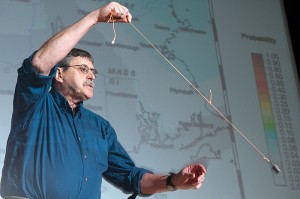
While the focus of attention in Haiti has been on the magnitude of human suffering since the Jan. 12 earthquake, geologists have an additional concern – the shifting of the earth’s crust.
In Haiti, close to a fault that has seen major quakes over hundreds of years, three factors contributed to the catastrophe: location, depth, and magnitude, said Regina Graziano, CLAS ’10, in a presentation by the Geology Club Feb. 18.
The epicenter of the quake was 10 miles southwest of Port-au-Prince, which is on soft ground that amplifies shaking. The earthquake was relatively shallow, causing more tremors on the surface, and the magnitude was 7 on the Richter scale of 1 to 10.
Making matters worse were the poor building conditions in Haiti, said Graziano, a geosciences major. A similar earthquake in California in 1989 (the “World Series” quake) measured 6.9 on the Richter scale and was along the San Andreas fault, a fault like the one in the Haiti quake. But it resulted in 63 deaths, compared with more than 200,000 in Haiti.
Haiti’s quake was felt as severe tremors by 3 million people, some as far away as Cuba and Jamaica, said Graziano, citing U.S. Geological Survey data. The plate slippage at the hypocenter, the underground version of an epicenter, was 4.6 meters, while the shift at the surface was about two meters, she said.

Two tectonic plates, or slabs of the earth’s crust, converge in the area. One – the North American plate – is north of Hispaniola, Haiti’s island home, and the Caribbean plate is to the south. The North American plate is moving westward, and the Caribbean plate is moving east. Their friction and slippage against each other has made quakes along the fault “predictable but unpredictable at the same time,” said Graziano.
While it’s difficult to predict earthquakes, it is possible to forecast them, said Vernon Cormier, a geophysics professor in the College of Liberal Arts and Sciences. A forecast of probability, location, and approximate time is very achievable in earthquake science, he said. On the other hand, a prediction is more precise, requiring an exact time, location, and size.
Earthquake scientists look for future quake sites along plate boundaries, focusing particularly on seismic gaps, or places along a fault where plate slippage has been inactive. The longer the gap, Cormier said, the higher the magnitude of earthquake that’s possible.
The Geology Club was organized this year in conjunction with the new geosciences major in the College of Liberal Arts and Sciences. The goal of the GeoClub is to take what students learn in the classroom and experience it in the real world. Activities have included several trips to local sites of interest. Although most of the club’s members are geosciences majors, it is open to students in any major.
Eunice Omega, CLAS ’10, also contributed to this article.


